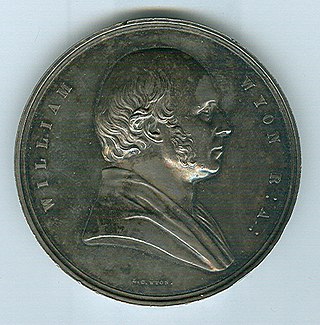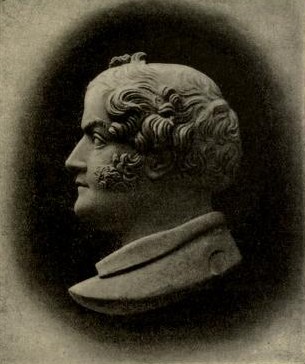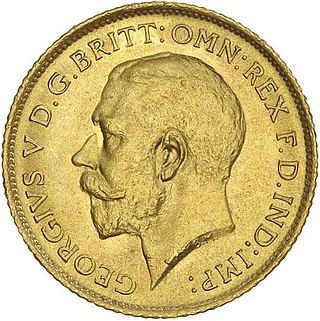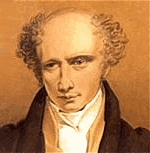
The penny of Great Britain and the United Kingdom from 1714 to 1901, the period in which the House of Hanover reigned, saw the transformation of the penny from a little-used small silver coin to the bronze piece recognisable to modern-day Britons. All bear the portrait of the monarch on the obverse; copper and bronze pennies have a depiction of Britannia, the female personification of Britain, on the reverse.

William Wyon, was official chief engraver at the Royal Mint from 1828 until his death.

The sovereign is a British gold coin with a nominal value of one pound sterling (£1) and contains 0.2354 troy oz of pure gold. Struck since 1817, it was originally a circulating coin that was accepted in Britain and elsewhere in the world; it is now a bullion coin and is sometimes mounted in jewellery. In addition, circulation strikes and proof examples are often collected for their numismatic value. In most recent years, it has borne the design of Saint George and the Dragon on the reverse; the initials of the designer, Benedetto Pistrucci, are visible to the right of the date.

Benedetto Pistrucci was an Italian gem-engraver, medallist and coin engraver, probably best known for his Saint George and the Dragon design for the British sovereign coin. Pistrucci was commissioned by the British government to create the large Waterloo Medal, a project which took him thirty years to complete.

The half sovereign is a British gold coin with a nominal value of half of one pound sterling. It is half the weight of its counterpart 'full' sovereign coin.
Several members of the Wyon family were noted medal makers:
Thomas Wyon the Younger was an English medallist and chief engraver at the Royal Mint.
The British farthing was a British coin worth a quarter of an old penny. It ceased to be struck after 1956 and was demonetised from 1 January 1961.

Henry Thomas Ryall was an English line, stipple and mixed-method engraver and later used mixed mezzotint.

Allan Gairdner Wyon FRBS RMS was a British die-engraver and sculptor and, in later life, vicar in Newlyn, Cornwall.

Charles Theodosius Heath was a British engraver, currency and stamp printer, book publisher and illustrator.
Edward Alexander Wyon was a London architect and poet, descended from the Wyon family of engravers. His only known building is St John the Evangelist Church in Hollington, Hastings in East Sussex. His posthumous publication, A Memorial Volume of Poems (1874), continues to be reprinted in the 21st century. He died in Hastings prior to his thirtieth birthday.

Allan Wyon (1843–1907) was an English medallist and seal-engraver.

Benjamin Wyon was a British engraver of seals, and medallist.
Joseph Shepherd Wyon was a British medallist and seal-engraver.
Thomas Wyon the elder (1767–1830) of the Wyon family was an English engraver of dies, who became Chief Engraver of the Seals.
Chief Engraver of the Royal Mint is a senior position at the British Royal Mint who is responsible for overseeing the preparation of coin dies.

Guy Alfred Wyon MD, BSc. was an English pathologist, researcher and lecturer, focusing mainly on bacterial growth and producing papers on the subject.











